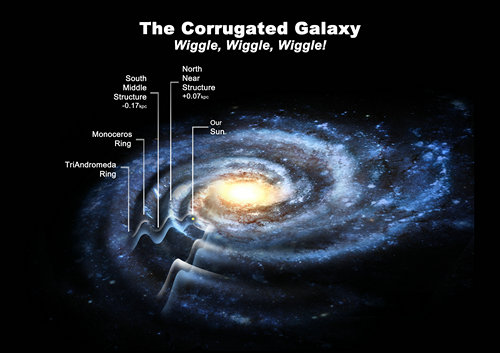The Milky Way galaxy is at least 50 percent larger than is commonly estimated, according to new findings that reveal that the galactic disk is contoured into several concentric ripples. The research, conducted by an international team formed by associate professor Yan Xu from National Astronomical Observatories, Chinese Academy of Sciences (NAOC), Professor Heidi Newberg, Dr. Jeffrey Carlin from Rensselaer Polytechnic Institute (RPI), associate professor Chao Liu, professor Licai Deng from NAOC, Ph.D Jing Li from Shanghai Astronomical Observatory (SHAO), Dr. Ralph Schonrich from University of Oxford, and Professor Brian Yanny from Fermi National Accelerator Laboratory, revisits astronomical data from the Sloan Digital Sky Survey (SDSS) which, in 2002, established the presence of a bulging ring of stars beyond the known plane of the Milky Way (2015, ApJ, 801, 105).
Xu, Newberg, and their collaborators used data from the Sloan Digital Sky Survey (SDSS) to show an oscillating asymmetry in the main sequence star counts on either side of the galactic plane, starting from the sun and looking outward from the galactic center. In other words, when we look outward from the sun, the mid-plane of the disk is perturbed up, then down, then up, and then down again. Importantly, the findings show that the features previously identified as rings are actually part of the galactic disk, extending the known width of the Milky Way from 100,000 light years across to 150,000 light years.
The new research builds upon a 2002 finding in which Newberg established the existence of the "Monoceros Ring", an "over-density" of stars at the outer edges of the galaxy that bulges above the galactic plane. When they revisited the data from SDSS, they found four anomalies: one north of the galactic plane at 2 kilo-parsecs (kpc) from the sun, one south of the plane at 4-6 kpc, a third to the north at 8-10 kpc, and evidence of a fourth to the south 12-16 kpc from the sun. The Monoceros Ring is associated with the third ripple. The researchers further found that the oscillations appear to line up with the locations of the galaxy's spiral arms. These findings support other recent research, including a theoretical finding that a dwarf galaxy or dark matter lump passing through the Milky Way would produce a similar rippling effect. In fact, the ripples might ultimately be used to measure the lumpiness of dark matter in our galaxy.

(Photo Credit: Heidi Newberg, Rensselaer Polytechnic Institute)
The research was funded by the NSF, as well as the Chinese National Science Foundation and the National Basic Research Program of China.
Professor Newberg currently researches the structure and evolution of our own galaxy, using stars as tracers of the galactic halo and disks. These stars in turn are used to trace the density distribution of dark matter in the Milky Way. She has been a participant of the Sloan Digital Sky Survey and is currently head of participants in LAMOST U.S., a partnership allowing U.S. astronomers to take part in a survey of more than 7 million stars by the Large Sky Area Multi-Object Fiber Spectroscopic Telescope in China (LAMOST).
For more details, please visit: http://news.rpi.edu/content/2015/03/09/rippling-milky-way-may-be-much-larger-previously-estimated